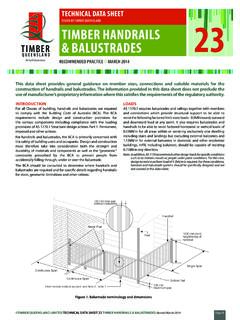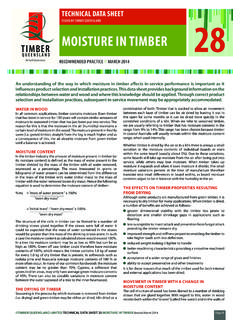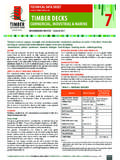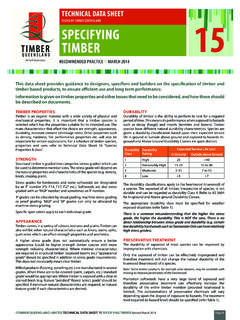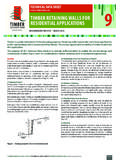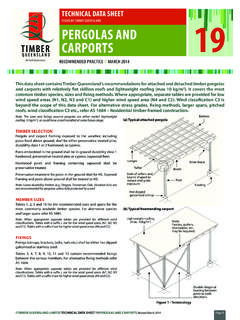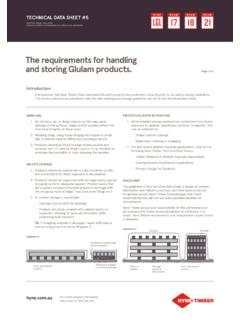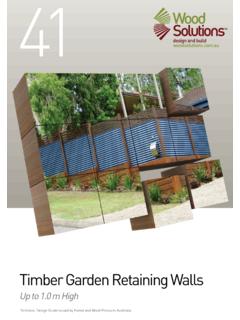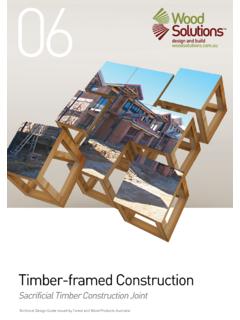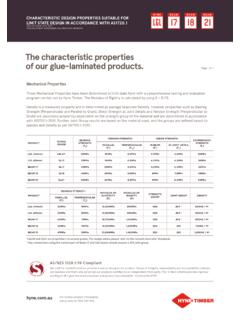Transcription of TECHNICAL DATA SHEET ISSUED BY TIMBER …
1 TIMBER QUEENSLAND LIMITED TECHNICAL data SHEET 20 residential TIMBER FENCES Revised March 2014 Page 1 TIMBER fences can provide an effective means of: defining property boundaries providing privacy from the street or neighbours confining pets reducing traffic noise screening from sun and wind providing a safety barrier around swimming pools or other data SHEET provides recommendations for the construction of domestic TIMBER fences up to 1800 mm high. It contains suggested paling sizes and configurations for the different , COVENANTS are various Government Acts, Local Authority planning and building regulations, as well as possible site covenants which could restrict or otherwise dictate the location, height, and/or construction of fences. Compliance with these regulations is necessary. There are special requirements for safety fences around swimming is necessary to reach prior agreement with neighbours regarding the fencing type, height etc, as well as the sharing of : Additional information is available from your local authority and from correct property alignments ( location of survey pegs) should be established before setting out boundary fencing.
2 Unless otherwise agreed with neighbours, the centre-line of posts should be positioned on the boundary QUALITYT here is no Australian Standard or other grading requirements for fencing TIMBER and the quality and cost can vary between different sold for fencing could contain certain natural characteristics (knots, gum veins, minor insect damage, want, wane, etc.) and some movement (cupping, twisting etc.) can be expected. This TIMBER quality is generally acceptable for domestic fencing a higher than normal appearance or performance is required for fencing, a higher quality TIMBER should be specified. For posts and railings, structurally graded TIMBER ( cypress F5, hardwood F11, treated pine F5 or MGP10) could be used. For palings the following limitations could be specified: no loose or unsound knots no decay or insect galleries no heart or pith gum, latex or resin pockets not to extend from one surface to another sound knots not to exceed 50% of face : Higher quality material could be at a higher cost than normal fencing timberSPECIES SELECTIONTo achieve a satisfactory service life, the following TIMBER is recommended for fencing: Cypress Sapwood in posts shall be limited to 20% of cross section and a maximum of 1/3 the width on adjoining faces.
3 Hardwood - Posts - In-ground Durability Class 1 or 2 - Rails & Palings - Above Ground Durability Class 1 or 2 Preservative treated TREATMENTAll pine and hardwood containing sapwood shall be preservative (and plinth boards where used) shall be treated to a minimum hazard level H4. Palings, rails, cappings etc., shall be treated to a minimum hazard level 1: MEMBER SIZESM emberHardwoodCypressTreated PineCorner andgate posts100 x 100 mmor125 dia. rounds100 x 100 mm90 x 90 mmor125 dia. roundsIntermediatePosts100 x 75 mmor100 dia. rounds100 x 75 mm90 x 70 mmor100 dia. roundsRails75 x 38 mm(2100 mm spacing)100 x 38 mm(2400 mm max. post spacing)75 x 50 mm(2100 mm spacing or100 x 38 mm (2400 mm max. post spacing) 70 x 45 mm (2100 mm spacing or90 x 35 mm (2400 mm max. post spacing)INSTALLATION OF POSTSFor most soil conditions, posts shall be set into ground approximately 450 mm deep for fences up to 1200 mm and 600 mm deep for fences between 1200 mm and 1800 mm high.))
4 Post holes shall be a minimum 300 mm : For poor soil conditions or higher fences, professional advice should be PRACTICE // MARCH 2014 residential TIMBER FENCESTECHNICAL data SHEETISSUED BY TIMBER QUEENSLAND20 TIMBER QUEENSLAND LIMITED TECHNICAL data SHEET 20 residential TIMBER FENCES Revised March 2014 Page 2 Posts shall be set plumb. Where not covered by capping, tops of posts shall be sloped to shed holes shall be filled with a minimum 100 mm coarse gravel, to allow holes to drain. The remainder shall be filled with rammed earth (tamped at 150 mm intervals), or concrete with top sloped to shed : No Fines concrete is recommended for hardwood of footing sloped away from postConcretefooting orrammed earth back ll100mmCourse gravel laid atthe base of the post100 mmmaximum100 mmmaximumIntermediate railfor fence over1200 mm highnotched 12 mmwhere requiredto fully house50 mm wide railsslope topof posts38 mm notch(maximum)Top sloped toshed water125 x 38 mmcapping xedto top railFIXING RAILSTwo rails may be used for paling fences up to 1200 mm high.
5 Fences exceeding 1200 mm and up to 1800 mm high require three shall be twice the length of the post spacing ( two spans) with joints in top and bottom rails of footing sloped away from postConcretefooting orrammed earth back ll100mmCourse gravel laid atthe base of the post100 mmmaximum100 mmmaximumIntermediate railfor fence over1200 mm highnotched 12 mmwhere requiredto fully house50 mm wide railsslope topof posts38 mm notch(maximum)Top sloped toshed water125 x 38 mmcapping xedto top railExcept where rails are required at the end of palings to fix capping or plinth, palings may project up to 100 mm beyond rails. Rails may be either notched into posts or fixed directly to the face. The maximum depth of notching shall be 38 mm for 100 mm deep posts and 35 mm for 90 mm : To fully recess 50 mm (45 mm) rails, the post shall be notched 38 mm (35 mm) and the rail notched 12 mm (10 mm).
6 Alternatively, larger posts could be coat of water repellent preservative or the priming coat of the selected finish should be applied to notches before fixing shall be fixed to posts with either: one 10 mm cup head bolt one No. 14 Type 17 batten screw two mm diameter bullet head nails or two mm flat head gun fixings shall be hot dipped galvanised or stainless and screws shall be 75 mm long for 38 mm rails and 90 mm long for 50 mm into treated pine shall have deformed used paling sizes are 100 x 15 mm and 75 x 15 may be spaced or closely : Shrinkage and other movement in palings can create gapping. Where total privacy is required, palings should be lapped (refer Sound Fences).Palings shall be fixed to rails with two hot-dipped galvanised or stainless steel : One nail per fixing is acceptable for first layer of lapped palings in sound hardwood palings, hand driven nails shall be bullet head.
7 For treated softwood palings, hand driven nails shall be flat head. Gun nails (for hardwood and treated pine palings) shall be either flat head or dome for 15 mm thick palings shall be either 50 x mm (hand driven) or 45 x mm (gun nails).Note: Longer nails are required for thicker palings and for lapped sound capping is provided (to protect end grain of posts and palings), top rails shall be flush with the top of posts and shall be 125 x 38 mm for hardwood or cypress and 120 x 35 mm for treated pine with top surface sloped to shed shall be fixed to top rail with 75 x mm nails at 450 mm of footing sloped away from postConcretefooting orrammed earth back ll100mmCourse gravel laid atthe base of the post100 mmmaximum100 mmmaximumIntermediate railfor fence over1200 mm highnotched 12 mmwhere requiredto fully house50 mm wide railsslope topof posts38 mm notch(maximum)
8 Top sloped toshed water125 x 38 mmcapping xedto top rail TIMBER QUEENSLAND LIMITED TECHNICAL data SHEET 20 residential TIMBER FENCES Revised March 2014 Page 3 PLINTHW here a plinth is provided at the base of sound fences, (to enclose small pets, etc.), bottom rails shall be positioned so that plinths and rails overlap a minimum of 25 shall be 125 x 38 mm cypress or durability class 1 hardwood, or 120 x 35 mm for treated shall be fixed to posts with the same fixings as for (120x35mm)plinth xedtoposts25 mm overlapBrace andmid rail halfchecked300 to 600rails to match adjacent fencebrace to rail design options100 mmmaximumorbrace to rail connection options10 mmnotchFINISHESU nprotected TIMBER exposed to the weather will fade to a silvergrey colour and could distort and develop splitting and surface checking. Where this is not desirable, various finishes can be applied to provide protection against these weathering effects of sun and rain.
9 The following can be applied: Good quality, light coloured Paints provide the best level of : Low quality, dark coloured paints and finishes that only provide a film over the TIMBER surface are not recommended. These products can accelerate decay. Clear Finishes may provide only short term protection and require frequent re-application. Stains provide reasonably good protection depending upon the amount of pigment and degree of , stains and clear finishes shall be applied in accordance with manufacturer s : Where preservative treated TIMBER is used, the compatibility of the selected coating should be shall be framed with vertical stiles, rails and diagonal braces of the same size as rails in the adjacent rails may be notched or half checked to stiles with the same fixings as fencing rails to posts.
10 Alternatively, rails and stiles could be mortice and tenoned or butted and joined with galvanised nail plates in accordance with manufacturer s sizes, number and spacing of gate rails shall match the adjacent bracing (same size as rails) shall be provided at an angle between 30 and 60 . Braces shall be fixed to rails with one Type 17 batten screw or two skew nails. Braces shall be either butted tightly against stiles or notched approximately 10 mm into rails within 100 mm of and latches shall be fixed in accordance with manufacturer s : Three hinges are recommended for gates with three rails ( over 1200 mm high).Palings shall be fixed to gates to match adjacent (120x35mm)plinth xedtoposts25 mm overlapBrace andmid rail halfchecked300 to 600rails to match adjacent fencebrace to rail design options100 mmmaximumorbrace to rail connection options10 mmnotchPOOL FENCEST here are various government and local authority regulations which control the construction of safety fencing around swimming pools.
